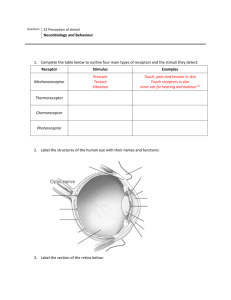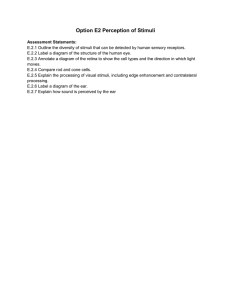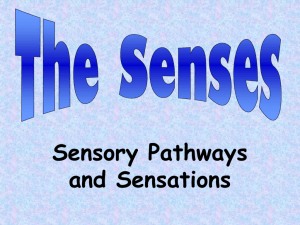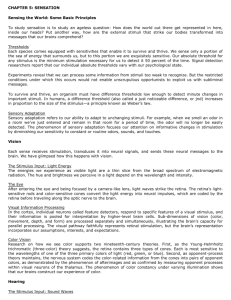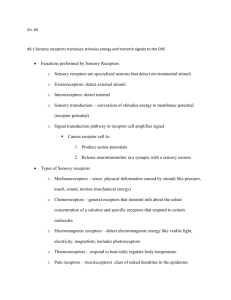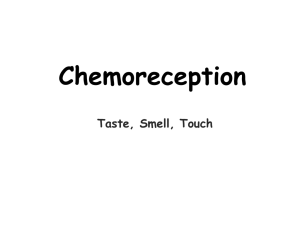Exercise 23 - 24
advertisement
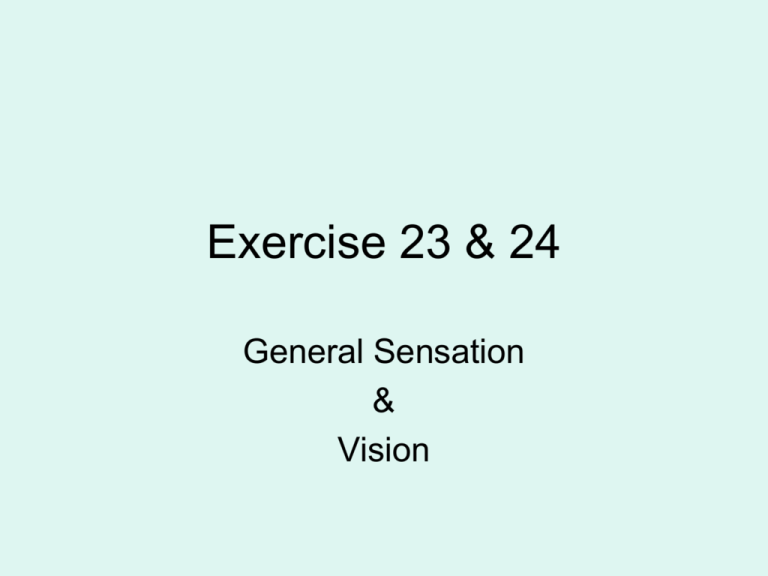
Exercise 23 & 24 General Sensation & Vision Sensory Receptors • Structures specialized to respond to stimuli • Activation of sensory receptors results in depolarizations that trigger impulses to the CNS • The realization of these stimuli, sensation and perception, occur in the brain • Mechanoreceptors – respond to touch, pressure, vibration, stretch, and itch • Thermoreceptors – sensitive to changes in temperature • Photoreceptors – respond to light energy (e.g., retina) • Chemoreceptors – respond to chemicals (e.g., smell, taste, changes in blood chemistry) • Nociceptors – sensitive to pain-causing stimuli Receptor Classification by Stimulus Type Receptor Class by Location: Exteroceptors • Respond to stimuli arising outside the body • Found near the body surface • Sensitive to touch, pressure, pain, and temperature • Include the special sense organs Simple Receptors: Unencapsulated Table 13.1.1 Simple Receptors: Encapsulated Table 13.1.2 Simple Receptors: Encapsulated Table 13.1.3 Adaptation of Sensory Receptors • Adaptation occurs when sensory receptors are subjected to an unchanging stimulus – Receptor membranes become less responsive – Receptor potentials decline in frequency or stop Chemical Senses • Chemical senses – gustation (taste) and olfaction (smell) • Their chemoreceptors respond to chemicals in aqueous solution – Taste – to substances dissolved in saliva – Smell – to substances dissolved in fluids of the nasal membranes Eye and Associated Structures • 70% of all sensory receptors are in the eye • Most of the eye is protected by a cushion of fat and the bony orbit • Accessory structures include eyebrows, eyelids, conjunctiva, lacrimal apparatus, and extrinsic eye muscles Palpebrae (Eyelids) Figure 15.5b Extrinsic Eye Muscles Figure 15.7a, b Structure of the Eyeball Figure 15.8a Pupil Dilation and Constriction Figure 15.9 Sensory Tunic: Retina Figure 15.10a Anterior Segment Figure 15.12 Focusing for Distant Vision • Light from a distance needs little adjustment for proper focusing • Far point of vision – the distance beyond which the lens does not need to change shape to focus (20 ft.) Figure 15.17a Focusing for Close Vision Figure 15.7b Problems of Refraction Figure 15.18 Astigmatism Visual Pathways Figure 15.23 Terms • • • • • • • • Accommodation Emmetropia: normal vision Myopia: near-sigthedness Hyperopia: far-sightedness Presbyopia: “old vision” Glaucoma: intraocular pressure imbalance Cataract: clouding of the lens Conjunctivitis: inflammation of the conjunctiva The Retina Retina



